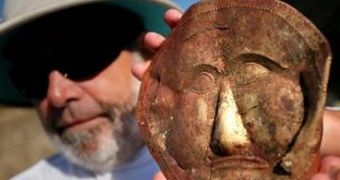These mighty warriors dominated the Balkans during a period ranging from the Indo-European invasion till their Roman conquest. The Thracian civilization was at least similar in terms of development to the ancient Greeks.
Now, archaeologists have found a 2,400-year-old golden mask that once belonged to a Thracian king in a timber-lined tomb in southeastern Bulgaria, near the village of Topolchane, 180 miles (290 kilometers) east of the capital, Sofia. The mask, found over the weekend, was discovered in the tomb along with a solid gold ring presenting a Greek inscription and a bearded face. There were also some other discovered items: a silver rhyton, silver and bronze vessels, pottery and funerary gifts.
"These finds confirm the assumption that they are part of the lavish burial of a Thracian king," said co-researcher Margarita Tacheva.
"The artifacts belonged to a Thracian ruler from the end of the 4th century B.C. who was buried here," said lead researcher Georgi Kitov.
The Thracians inhabited what is now Bulgaria, Romania and parts of modern Greece, Macedonia and Turkey between 4,000 B.C. and the 8th century A.D., when they were assimilated by the invading Slavs.
In 2004, another 2,400-year-old golden mask was found in a Thracian tomb in the same area. Dozens of Thracian mounds spot central Bulgaria, an area dubbed "the Bulgarian valley of kings" in reference to the Valley of the Kings near Luxor, Egypt, harboring the tombs of Egyptian Pharaohs.
Still, Thracians of modern Romania, called Dacians (Getae), were the most famous as they formed powerful kingdoms that fiercely resisted Roman occupation. Modern Romanians still consider themselves Romance (Latin-rooted) language speaking Thracians (Dacians) and in Transylvania, the center of the ancient Dacians' kingdom, there are still intense investigations for Dacian gold treasures, some of which were found throughout time: from coins to bracelets and royal helmets.
Many Thracian rooted words are still found in Romanian and Albanian languages and there is a debate whether Albanian is not just a modern-day Thracian idiom.

 14 DAY TRIAL //
14 DAY TRIAL //